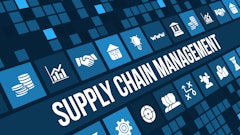
Takeaways:
- The financial supply chain is less efficient than the physical supply chain
- Improve visibility to improve forecasting and planning
- Collaborative platforms provide visibility for buyers and suppliers and allows for quick resolution of disputes
- The ability to tie the financial process to what’s actually happening in the physical supply chain can open up opportunities for buyers, sellers and banks
Companies are leaving millions of dollars on the table because of inefficiencies in the financial supply chain while the physical supply chain has evolved more efficiently. Is it time to marry the physical supply chain to the financial supply chain to improve the situation? Supply & Demand Chain Executive recently discussed this complex issue with experts in the field.
One key solution, experts agree, is to improve visibility into the supply chain, which will allow businesses to improve forecasting and planning. Companies need timely, cleansed data coming from their trading partners. If logistics providers and financial services firms can provide substantial visibility into the physical and financial supply chains, their clients will be able to make well-educated decisions.
It is a given, however, that the financial supply chain is less efficient than the physical supply chain. From 1960 to 2000, the physical supply processes of ordering and delivery have shortened from 20-plus days to the same day, according to Kurt Schneiber, CEO of Minneapolis-based Syncada. “The supporting financial processes have not been optimized during the same time period,” he says. “Invoice processing and payment times have remained the same, lingering between 45 and 60 days on average.”
Ask yourself this
Exacerbating the situation is a lengthening of the physical supply chain (shipping longer distances) and associated higher costs, says Bob Heaney, senior research analyst, supply chain management, Aberdeen Group in Boston. At the same time, oil prices are skyrocketing, which creates a double whammy: greater distance and higher fuel surcharge. “Many companies are relying on outside experts, so they can track what is happening in this extended supply chain,” he notes. “This poses a big challenge and opportunity for companies trying to make a profit in today’s business environment.”
From a financial standpoint, Heaney adds, supply chain executives need to ask themselves the following questions: Do we have timely, cleansed data coming from our trading partners? Is that integrated into our data system so we can truly see what is happening from a planning and execution standpoint? Do we know what our margins will be on imported products? Exactly where are our products in the supply chain?
According to Schneiber, optimization is the key. “Without optimization, which usually means automation, it’s difficult to reap the full benefits of supply chain finance on a large scale,” he explains. “While supply chain financing can occur without the use of technology, there is a growing trend toward accessing supply chain financing as part of an overall automated solution.” If the time between invoicing and payment can be shortened via automation, he adds, there is an even stronger value proposition for supply chain financing because suppliers can gain the benefit of getting cash quickly to redeploy into their businesses.
Making adjustments
On the positive side, the financial supply chain is making adjustments to these new global processes, experts agree. But is the pace fast enough? “Financial supply chains (FSCs) are evolving, but not as quickly as advances in the physical supply chain,” says Nathan Pieri, senior vice president of marketing and product management at East Rutherford, N.J.-based Management Dynamics. “As barriers continue to fall, however, convergence of financial and physical supply chains will become more prevalent.”
Still, challenges exist. Pieri says today’s FSC typically lacks true operational insight to a supply base; the ability to automatically reconcile transactions; and the ability to fine-tune credit decisions based on expanded risk metrics.
Is it time to marry the physical supply chain to the financial supply chain? Yes, experts agree, but few companies have truly achieved this. The ability to tie the financial process to what’s actually happening in the physical supply chain can open up opportunities for buyers, sellers and banks. Historically, though, it has been hard for companies to get a reliable view into the movement of goods, the chain of custody and the commercial documents that are generated along the way.
One solution lies in advanced global trade management (GTM) platforms that can power FSC for financial institutions and corporations alike, according to Pieri. “Integration of GTM solutions helps automate the reconciliation process and eliminates the need to express mail documents, thus increasing data accuracy and improving cash cycle times,” he says. “GTM also helps manage risk by better forecasting potential issues with the addition and analysis of operational metrics.”
Most buyers view payment as a fulfillment of an obligation, adds Schneiber, but by automating the FSC and offering supply chain financing, buying organizations can be more strategic with their payments. “The payment becomes a way to maintain a healthy supply chain by providing suppliers with access to liquidity while still maintaining days-payable outstanding for the buyer. It’s a more collaborative model,” he notes.
An opportunity
Of utmost importance is the ability to provide information/visibility into the disposition of goods, or the ability to “see” where goods are at any point in the supply chain. “There is an opportunity to drive down costs through better visibility and control in the supply chain,” says Greg Kefer, director of corporate marketing, GT Nexus in Oakland, Calif. “Many companies still use costly financing mechanisms such as letters of credit because they don’t have the level of information control necessary to move to an open account model.”
C.J. Wimley, executive vice president, corporate solutions, SunGard’s AvantGard Corp. in New York City, says that corporations must reduce the friction that currently exists in many financial supply chains in order to facilitate the timely flow of information. Up-to-date and accurate information allows a corporation to more fully understand its cash flow and to execute initiatives such as alternative financing, foreign exchange hedging and risk management with more confidence, he notes.
Enter the Cloud
As for merging the physical and financial supply chains, the logistics side of the operation already has much of the information needed to do innovative things on the financing side, says Kefer, but this requires a platform that is capable of tracking inventory movement and related documentation across every stage of the global supply chain. “That’s hard to do, but increasingly possible with modern Cloud-based supply chain technology platforms,” he explains.
Kefer says this involves creating a new, more efficient business model: Cloud supply chain platforms that deliver a level of visibility not achievable with traditional software. “Traditional business software is designed to automate processes within a single company, not between companies. Cloud inverts the traditional model by placing a platform outside a company’s ‘four walls’ where all supply chain partners can link to and share. Like Facebook, it puts everybody on the same information page.”
According to John Sicard, chief operating officer, Kinaxis in Ottawa, Canada, profitability management must become a priority for every part of the operation—not just for finance. Multiple functions must be able to model costs across various dimensions to enable real-time profitability management. “By running ‘what-if’ scenarios using real operational data, key stakeholders can understand the financial implications of supply and demand changes both before and when they happen,” he says. “Companies that adopt an operational control tower model, which integrates multiple business processes with supply chain operations, will be able to instantaneously analyze the financial effects when reality deviates from the plan.”
Looking ahead, should banks and logistics companies develop new offerings that benefit buyers and suppliers—making it easier for buyers and sellers to trade? According to Pieri, these tools are available today. “It is really more about financial services firms taking advantage of the wealth of data and collaborative business processes to lower costs, improve performance, increase accuracy and improve compliance.” He even sees an opportunity for logistics providers to “forward integrate” and become distributors—to facilitate flows in a lean production model.
While collaboration seems to be the new buzz word, there is a reason it’s getting a lot of attention, adds Schneiber. “Collaborative platforms provide visibility for buyers and suppliers and allows for quick resolution of disputes,” he says. “Banks and other organizations should consider offerings that reduce the friction between the buyer and supplier—essentially making it easy to trade and get paid for it.”
Neal Lorenzi is a freelance writer based in Mundelein, Ill. He has covered a wide range of industries during his 25 years as a writer and editor.



















